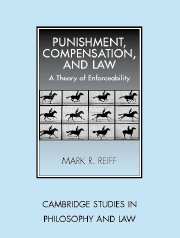Book contents
- Frontmatter
- Contents
- Acknowledgments
- Introduction
- 1 The Means of Enforcement
- 2 The Goals of Enforcement
- 3 Measuring Enforceability in the Previolation State of Affairs
- 4 Measuring Enforceability in the Postviolation State of Affairs
- 5 The Relationship between Previolation Expectations and Postviolation Practice
- 6 Limitations on the Means of Enforcement
- 7 Special Problems with Legal Remedies
- 8 The Value of Nominal Rights
- References
- Index
- Titles in the series
5 - The Relationship between Previolation Expectations and Postviolation Practice
Published online by Cambridge University Press: 15 August 2009
- Frontmatter
- Contents
- Acknowledgments
- Introduction
- 1 The Means of Enforcement
- 2 The Goals of Enforcement
- 3 Measuring Enforceability in the Previolation State of Affairs
- 4 Measuring Enforceability in the Postviolation State of Affairs
- 5 The Relationship between Previolation Expectations and Postviolation Practice
- 6 Limitations on the Means of Enforcement
- 7 Special Problems with Legal Remedies
- 8 The Value of Nominal Rights
- References
- Index
- Titles in the series
Summary
Before we leave our examination of the measurement of previolation and postviolation enforceability, there is one further issue we must address. Recall that when we began our examination of postviolation enforceability, we saw that (subject to a few limited exceptions) deterrence was not (indeed, could not be) a factor in determining the enforceability of a right that had already been violated. The beneficiary was already in the postviolation state of affairs with regard to that right, so determining whether that right should be considered enforceable meant deciding whether the punishment actually imposed sufficiently satisfied the requirements of retribution, not deterrence. But while the amount of punishment actually imposed in the postviolation state of affairs could not have any deterrent effect on a violation that had already occurred, we also noted that it could have a deterrent effect on violations yet to come, for what is past for one right is prologue for many others. Every instance of postviolation punishment becomes part of the background pattern of postviolation practice of the society in which we live, and potential violators are likely to consider past postviolation practice as some evidence of the amount of punishment to which they are likely to be exposed should they commit a violation in the future. And if past postviolation practice is likely to influence the behavior of future potential violators, it will also influence the future previolation expectations of beneficiaries.
- Type
- Chapter
- Information
- Punishment, Compensation, and LawA Theory of Enforceability, pp. 175 - 190Publisher: Cambridge University PressPrint publication year: 2005

